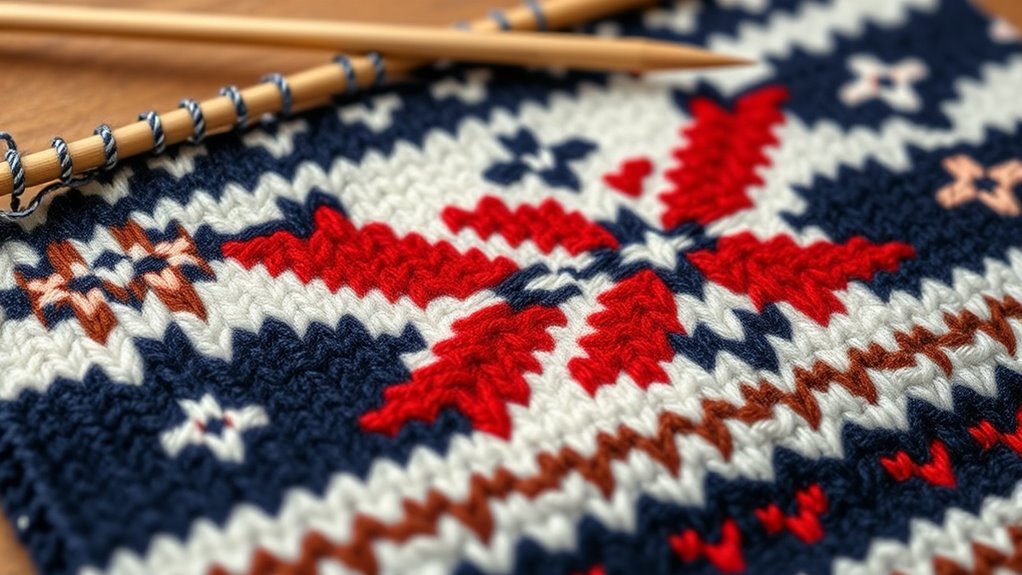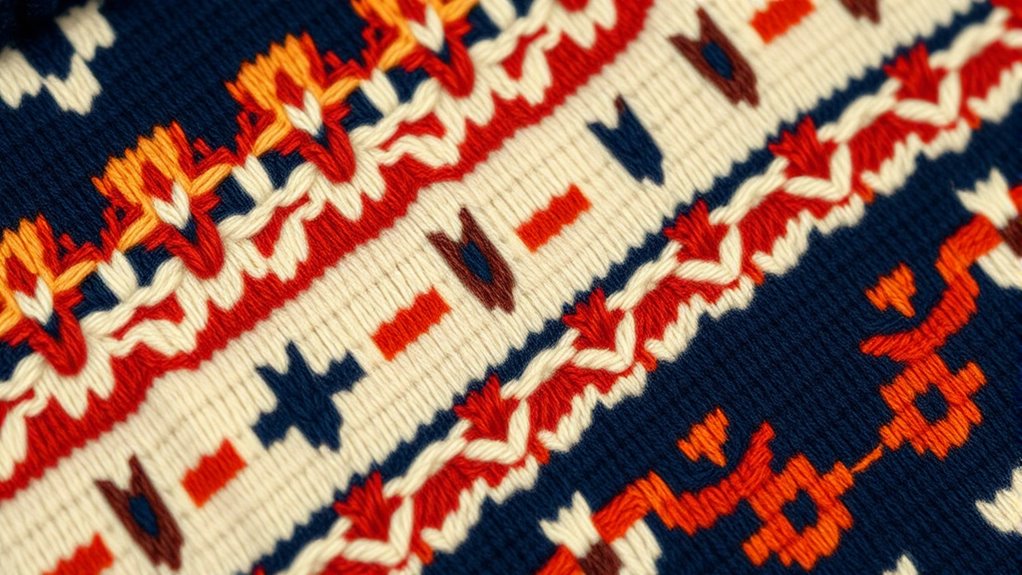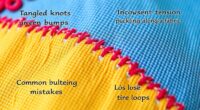Knitting colorwork involves techniques like Fair Isle and Intarsia to create vibrant, detailed patterns. With Fair Isle, you carry multiple colors across a row, controlling tension to keep floats neat and the fabric even. Intarsia works with blocks of color, changing yarns as you go to form shapes or images. Mastering tension management and pattern reading helps your projects look polished. Keep exploring these methods to develop your skills and produce professional-looking colorwork designs.
Key Takeaways
- Maintain consistent yarn tension to ensure smooth color transitions and even stitches in both Fair Isle and Intarsia.
- Familiarize yourself with pattern charts, symbols, and instructions before starting to ensure accurate color placement.
- Use proper techniques to control yarn tension, preventing puckering and floats for a neat, professional appearance.
- Manage yarns effectively: carry colors across rows in Fair Isle, and organize bobbins or yarns in Intarsia for clean color blocks.
- Practice regularly to develop skills in tension control and pattern reading, resulting in vibrant, high-quality colorwork projects.

Have you ever wanted to add vibrant patterns to your knitting projects? If so, mastering the basics of colorwork is essential. When you start working with multiple colors, it’s important to pay close attention to your yarn tension. Maintaining consistent yarn tension ensures that your color transitions are smooth and that your stitches stay even. If your yarn tension is too tight, your fabric might become stiff and difficult to work with. Conversely, if it’s too loose, your stitches may become uneven, causing the pattern to look sloppy. Practice adjusting your tension as you go, and don’t be afraid to pause and re-tension if needed. This will help keep your fabric balanced and your colorwork crisp.
Consistent yarn tension is key to smooth, even, and professional-looking colorwork in knitting.
Another key aspect is pattern reading. Before you begin, carefully study the pattern instructions and charts. Colorwork patterns, such as Fair Isle and Intarsia, often include detailed charts that show where each color needs to be used. Reading these charts accurately is vital for getting the design right. Take your time to familiarize yourself with the symbols and color codes. As you knit, keep track of your row and stitch counts, so you stay aligned with the pattern. This prevents mistakes that can lead to puckering or misaligned motifs. If you’re new to pattern reading, it can be helpful to mark sections or use a row counter to stay organized.
When working with Fair Isle, you’ll carry multiple colors across your row, creating intricate, repeating patterns. Here, controlling yarn tension becomes even more important. Too tight, and your floats—long strands of unused yarn on the back—will pull and cause puckering. Too loose, and your floats will be loose and floppy, disrupting the neatness of your design. Practice maintaining even tension with each color and learn to catch the floats regularly to keep the fabric even. With Intarsia, you’ll work with blocks of color, changing yarns for different sections. It requires careful pattern reading to know where to change colors and how to manage the yarns on the back. Keep your tension consistent as you switch colors to avoid gaps or puckering at the color joins.
In both techniques, patience and practice are your best tools. Pay close attention to your yarn tension and pattern reading skills, and you’ll soon be creating vibrant, professional-looking colorwork that stands out. With time, your confidence will grow, and so will your ability to handle complex motifs with ease.
Frequently Asked Questions
What Are the Best Yarn Types for Colorwork Projects?
For colorwork projects, you should choose yarns with good yarn softness and vibrant color dyeing. Wool blends, like merino wool or wool-acrylic mixes, are excellent because they’re soft, durable, and hold color well. Cotton or silk blends can also work if you prefer a smoother feel. Avoid rough or loosely spun yarns, as they can make your stitches less even and affect the overall look of your colorwork.
How Do I Choose Colors That Work Well Together?
When choosing colors, focus on a strong color palette selection with contrasting hues that make your design pop. Opt for colors that complement each other or create striking contrast, like dark and light shades. Consider the overall mood you want to achieve and test swatches to see how the hues work together. Trust your instincts, and don’t be afraid to experiment until you find a combination that excites you!
Can Beginners Successfully Learn Fair Isle and Intarsia?
You might wonder if beginners can master Fair Isle and Intarsia—absolutely, but it’s a journey filled with challenges. With patience and focused skill-building exercises, you’ll see progress, layer by layer. Start simple, practice tension control, and learn to read patterns. These techniques aren’t just for experts; they’re tools that reveal your potential step by step, making intricate designs achievable and incredibly rewarding.
How Do I Prevent Tension Issues With Multiple Colors?
To prevent tension issues with multiple colors, focus on maintaining consistent yarn tension as you knit. Keep your yarns relaxed but not slack, and use your fingers to gently control tension. This helps achieve even stitches, preventing puckering or tightness, and guarantees smooth color blending. Practice regularly, and don’t pull too tight when switching colors. With patience, your colorwork will look neat and professional.
What Are Common Mistakes to Avoid in Colorwork Knitting?
You might worry about yarn pooling or color dominance, but avoiding common mistakes can help. Keep your tension even to prevent yarn pooling, and choose colors with good contrast to avoid unwanted blending. Don’t forget to double-check your chart frequently and maintain consistent tension throughout. Also, avoid twisting yarns unnecessarily, which can lead to uneven color distribution. These tips ensure your colorwork remains vibrant and well-defined.
Conclusion
Once you master Fair Isle and intarsia, you’ll find knitting becomes like painting with yarn, creating vibrant stories on fabric. I once watched a beginner transform a simple sweater into a colorful masterpiece, just like a painter adding bold strokes to a canvas. Remember, each colorwork project is a journey—your needles are your brush, and the yarns are your palette. Embrace the process, and soon your creations will weave stories as vivid as a sunrise.









